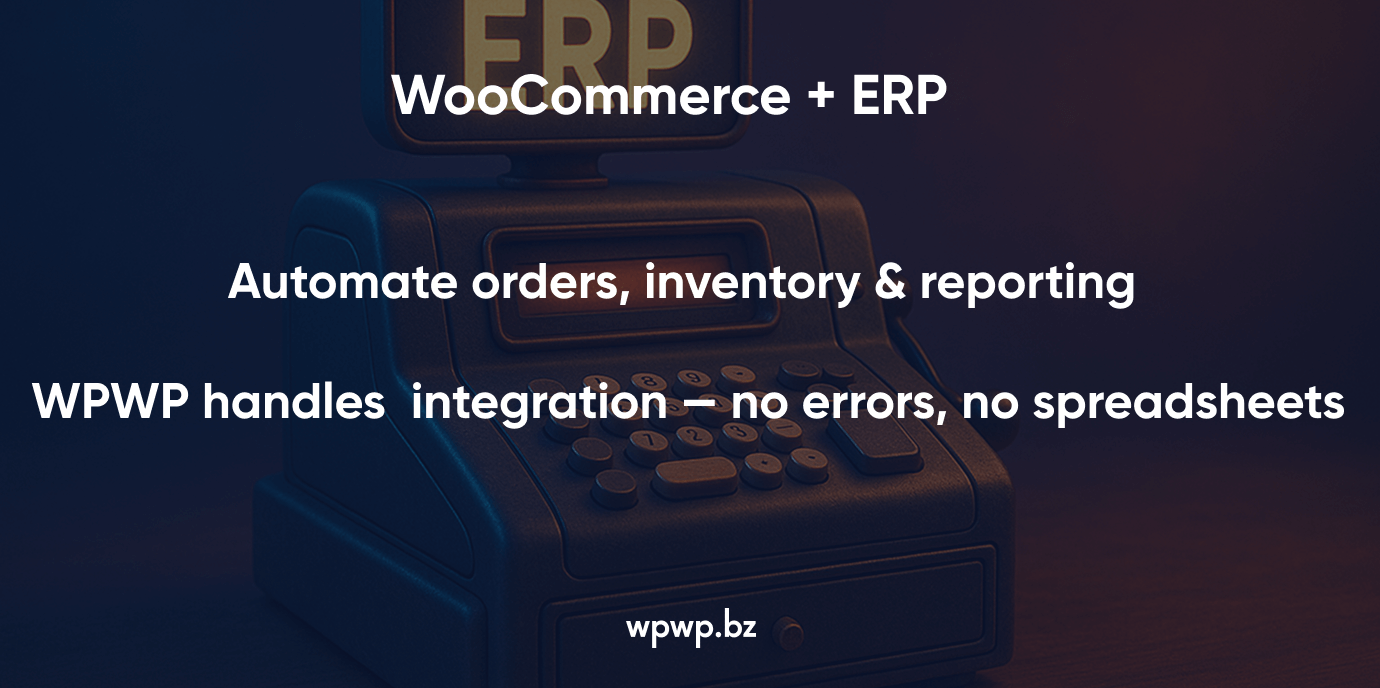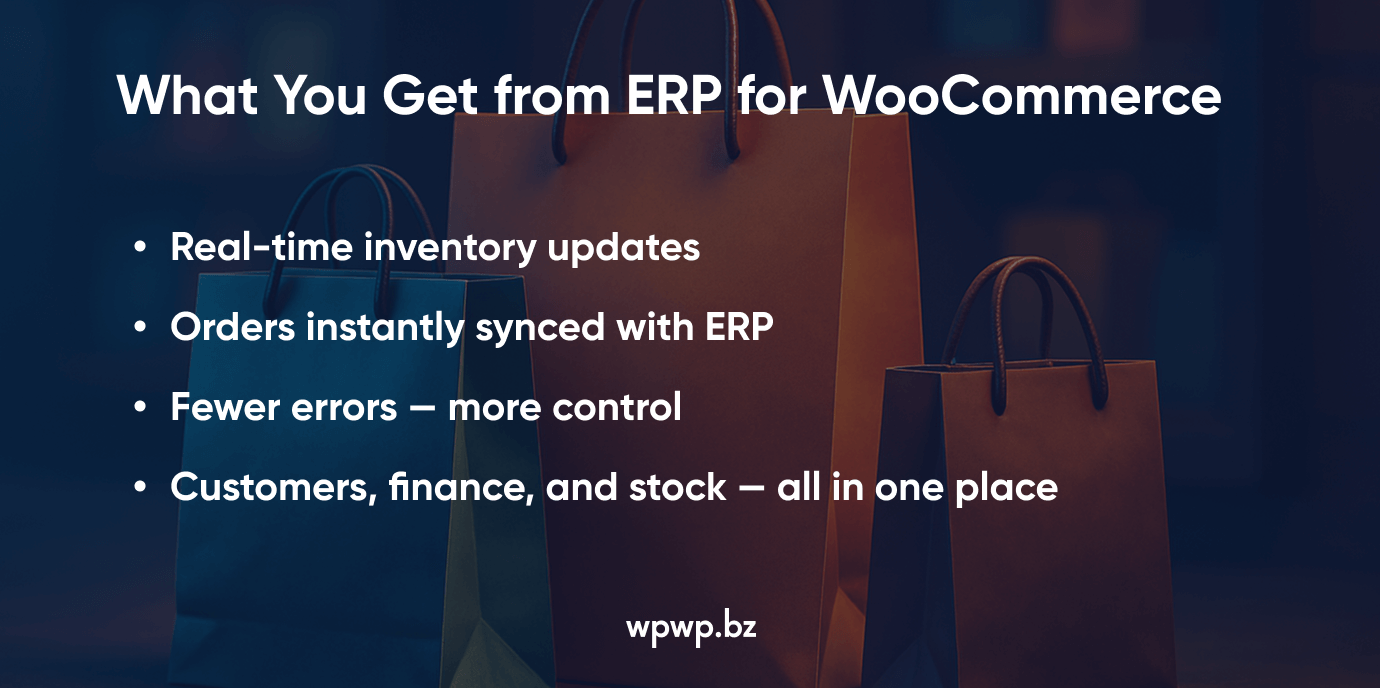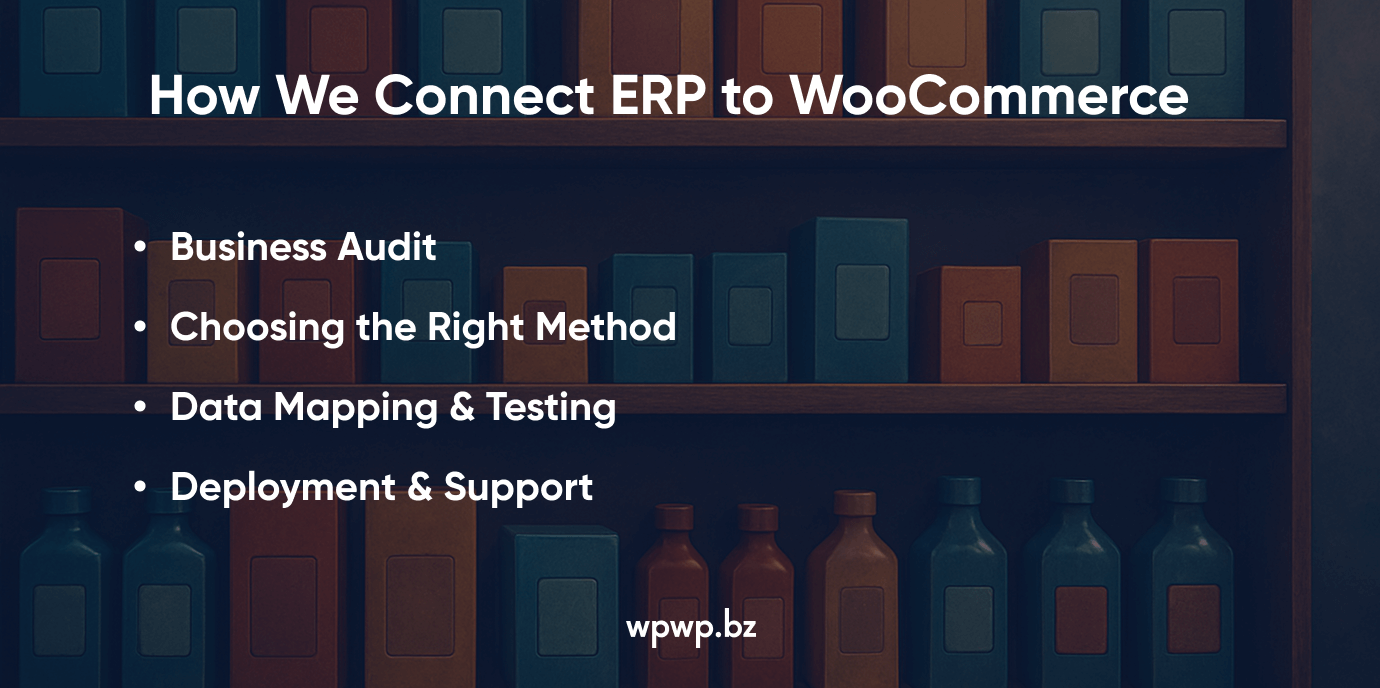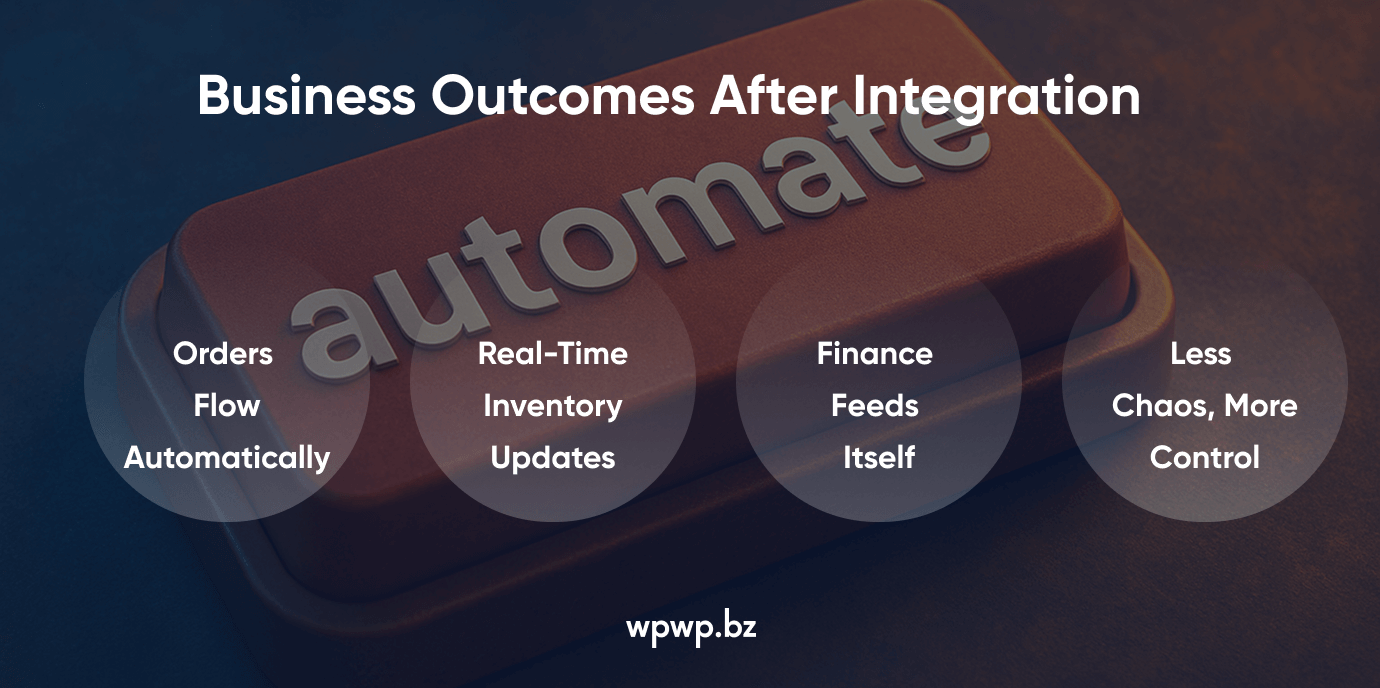At WPWP.BZ, we connect WooCommerce to the systems you already rely on, including SAP, Oracle NetSuite, Odoo, and Microsoft Dynamics 365. We’ve done it for manufacturers, distributors, and multi-channel retailers with solutions built around how they actually work, not how software thinks they should.
Some projects need a plugin. Others need middleware or a custom API. We’ll help you choose the right approach, then implement it properly.
If you’re tired of disconnected systems and patchwork fixes, we can help you get your operations in sync, once and for all.

Why Integrate ERP with WooCommerce?
Running an online store sounds smooth, until you’re knee-deep in mismatched numbers. The order shows up in WooCommerce, but inventory hasn’t been updated. Finance asks for figures, but they’re not quite right. You patch it up manually, again.
Eventually, the cracks start to show.
Integrating an ERP with WooCommerce cuts that mess out of the process. Orders move from cart to system without anyone copying and pasting. Inventory updates automatically. Finance has the data before they even ask.
It’s not just cleaner — it’s faster. It’s smarter. Everything ties together, without extra effort.
The benefits are clear. Real-time stock levels. Fewer fulfillment errors. One set of numbers everyone can trust. If you’ve been working across disconnected tools, this kind of setup feels like a breath of fresh air.
That’s what proper ERP integration does for eCommerce. It doesn’t just make things easier, it makes them right.

Top ERP Systems for WooCommerce
There’s no “best” ERP for WooCommerce. It really depends on how your business operates day to day — how many products you sell, how complex your supply chain is, and what kind of tools you already rely on.
SAP
SAP is big. Not just in brand, but in how it functions. It’s built for companies with serious logistics — warehouses, manufacturing, multiple regions. If you’re already using it, connecting it to WooCommerce isn’t exactly plug-and-play, but it can be done. And when it’s done well, it works without drama. Data flows. Orders update. Inventory stays sane.
NetSuite
This one’s a bit easier. NetSuite has that balance — powerful, but not overkill. It’s a good fit if your team is growing and you want your systems to grow with you. A lot of stores link NetSuite to WooCommerce to simplify inventory and finance. There’s usually a connector involved, sometimes a few tweaks, but it doesn’t require a full dev team to get started.
Odoo
Odoo’s different. More flexible. It’s open-source, which means you can mold it to fit how your business runs, not the other way around. It’s especially good for smaller operations that don’t want to pay for features they’ll never use. The catch? You’ll probably need a developer to get WooCommerce talking to it properly. But once that’s in place, it runs well.
Dynamics 365
If your business already leans into Microsoft, Dynamics fits right in. It’s not the flashiest ERP out there, but it connects departments in a way that makes sense. With the right integration, WooCommerce feeds data into your workflows and keeps your team on the same page.
At the end of the day, it’s not about picking the biggest name. It’s about picking what fits. We’ve seen companies do well with all four, but only when the system actually matches their needs.
WPWP.BZ’s Approach to ERP Integration: Plugin, Middleware, or Custom API
Before we talk tools or code, we ask a simple question: how does your business actually run?
That sounds obvious, but it’s where most integrations go wrong. We start every project with a deep dive into your day-to-day — how orders flow, where delays happen, what your ERP handles (and what it doesn’t). From there, we can figure out the best way to connect WooCommerce to it without breaking anything.
Sometimes, the right answer is a plugin. Let’s say you’re using Odoo — there are plugins that handle most of the basics: syncing products, tracking orders, updating customer info. A clean Odoo WooCommerce plugin setup might be all you need, especially if your business isn’t doing anything out of the ordinary.
But often, it’s not that simple.
Plugins don’t always cover edge cases. Maybe you’ve got a weird pricing model. Maybe your ERP tracks stock differently than WooCommerce does. When that happens, we look at middleware. These tools sit in the middle and help systems “speak the same language.” A good ERP middleware integration for WooCommerce can save a lot of time, especially if you’re working with multiple tools — accounting, inventory, logistics, all at once.
Still, there are times when neither option cuts it.
If you’re using something like SAP, or a heavily customized system, we’ll probably go with a full custom ERP integration. That means building an API connection from the ground up. A proper WooCommerce SAP connector isn’t something you download. We write it. Configure it. Test it. And make sure it doesn’t fall apart when traffic spikes.
No matter the method, one step we never skip is mapping. Orders, inventory, customers, payments — we match every field between platforms, test it, then test again. The goal isn’t just for data to move. It has to move correctly, every time.
After that, we deploy it. Quietly. Cleanly. You don’t have to babysit it, and if something breaks in the future, we’re still around.
We’ve learned this stuff doesn’t work unless it fits how your business actually runs. That’s the part most people miss. We don’t.

Business Outcomes After ERP Integration
When everything’s connected — your store, your ERP, your inventory, your finances, the difference is obvious. Things just work better.
Orders come in, get processed, and move to fulfillment without anyone touching a spreadsheet. That’s what automated order fulfillment with WooCommerce ERP looks like. It doesn’t mean zero human input. It means your team isn’t fixing mistakes caused by systems that don’t talk to each other.
You also stop guessing when it comes to stock. With real-time inventory updates, your store always knows what’s available. No more overselling. No more awkward emails saying, “Sorry, we’re out.” If something sells out, it reflects immediately and when it’s restocked, it shows up too. Customers get a smoother experience. Your staff stops playing inventory detective. And then there’s the finance side.
With ERP-driven financial reporting in WooCommerce, you stop relying on disconnected exports and late reports. Sales, refunds, tax, revenue — all of it ends up where it should, when it should. Accounting sees what happened today, not two weeks ago. That kind of visibility helps when you’re planning, scaling, or just trying to stay out of the dark.
We’ve seen stores go from total chaos to a system that runs quietly in the background. It’s not about fancy dashboards or buzzwords. It’s about getting time back, reducing errors, and letting people focus on the actual work.
That’s what proper ERP integration gives you. Clean data. Better decisions. And room to grow without losing control.

Compare Integration Methods: Plugin vs Middleware vs Custom API
There’s more than one way to link an ERP system with WooCommerce and each option comes with its own ups and downs. We usually look at three main methods: plugins, middleware, and custom API builds.
Plugins
The simplest route. A WooCommerce ERP plugin (like an Odoo connector) can get you up and running fast. It’s usually the cheapest option, and in a lot of cases, it’s enough. But plugins come with trade-offs. You’re working with someone else’s logic, and if your business doesn’t fit that logic, you’ll run into limits. Support can also be hit or miss. Updates might break something. So while the setup is quick, maintenance can be a pain.
Middleware
A step up in flexibility. Middleware tools, like ZapERP, Webgility, or similar, act as the go-between. They pull data from WooCommerce, talk to your ERP, and keep things in sync. A middleware ERP integration for WooCommerce gives you more control than a plugin, but without having to build everything from scratch. That said, these tools can get expensive over time. And you’re still relying on a third-party platform in the middle of your operations.
Custom API Integration
This is the deep end. A custom API ERP integration with WooCommerce gives you full control — over how data flows, what syncs, and when. It’s ideal when you’re using something like SAP or a highly customized ERP. But it comes at a cost: longer timelines, more testing, and the need for good documentation. You’ll need developers who know what they’re doing. But once it’s done, you’re not boxed in by someone else’s system.
At the end of the day, it comes down to what your store actually needs and what kind of control, flexibility, or simplicity you’re after. We walk clients through the pros and cons of each, because getting this decision wrong usually costs more than doing it right the first time.
Ready to Automate Your WooCommerce with ERP? Let WPWP.BZ Do It for You
You’ve seen what’s possible when WooCommerce and your ERP are properly connected — clean data, faster operations, fewer mistakes. The right setup keeps your store running smoother, especially when things scale.
At WPWP.BZ, we handle ERP integration from start to finish. Whether you’re using SAP, NetSuite, Odoo, or Dynamics, we’ll help you figure out the best approach — plugin, middleware, or a custom WooCommerce ERP solution and actually get it working the way your business needs.
We’re not guessing. We’ve done this before for fast-growing DTC brands, manufacturers, wholesalers, and subscription stores. Every build starts with a workflow audit, followed by a clear plan, clean field mapping, full testing, and ongoing support.
If you’re looking to hire WooCommerce ERP integration experts, you’re in the right place. We’re not just a development team — we’re a partner that understands operations.
Need a quote? Want to talk through your stack? Start with a quick audit, we’ll take it from there.














